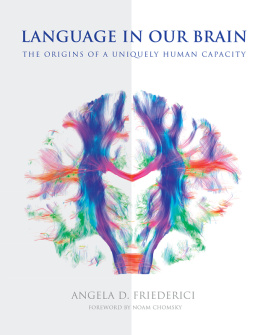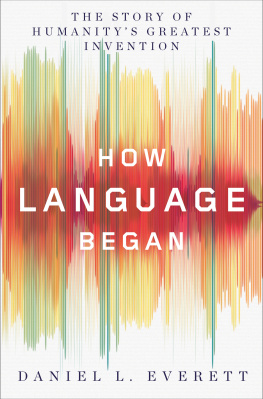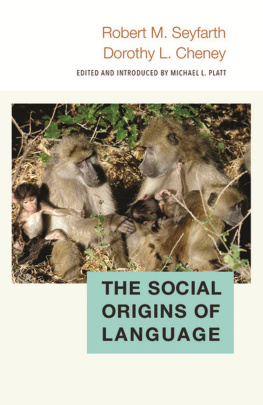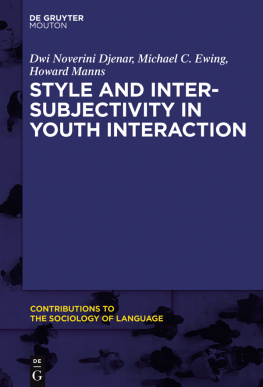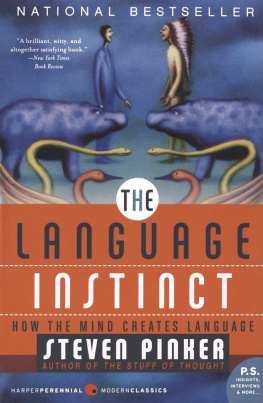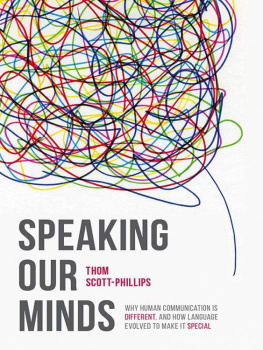Contents
List of Figures
List of Tables
Guide
Pagebreaks of the print version
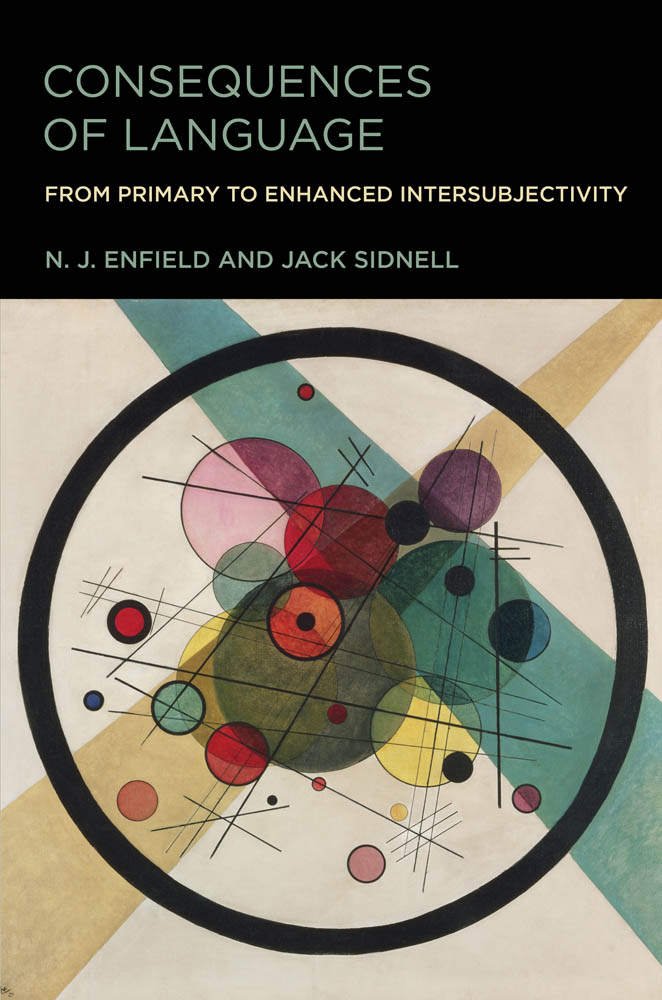
Consequences of Language
From Primary to Enhanced Intersubjectivity
N. J. Enfield and Jack Sidnell
The MIT Press
Cambridge, Massachusetts
London, England
2022 N. J. Enfield and Jack Sidnell
This work is subject to a Creative Commons CC-BY-NC-ND license.
Subject to such license, all rights are reserved.

The MIT Press would like to thank the anonymous peer reviewers who provided comments on drafts of this book. The generous work of academic experts is essential for establishing the authority and quality of our publications. We acknowledge with gratitude the contributions of these otherwise uncredited readers.
Library of Congress Cataloging-in-Publication Data
Names: Enfield, N. J., 1966 author. | Sidnell, Jack, author.
Title: Consequences of language : from primary to enhanced intersubjectivity / N. J. Enfield and Jack Sidnell.
Description: Cambridge, Massachusetts : The MIT Press, [2022] | Includes bibliographical references and index.
Identifiers: LCCN 2022006408 (print) | LCCN 2022006409 (ebook) | ISBN 9780262544863 (paperback) | ISBN 9780262372732 (epub) | ISBN 9780262372749 (pdf)
Subjects: LCSH: Social interaction. | Intersubjectivity. | Anthropological linguistics. | Semantics.
Classification: LCC HM1111 .E536 2022 (print) | LCC HM1111 (ebook) | DDC 302dc23/eng/20220428
LC record available at https://lccn.loc.gov/2022006408
LC ebook record available at https://lccn.loc.gov/2022006409
d_r0
While we often speak of society as though it were a static structure defined by tradition, it is, in the more intimate sense, nothing of the kind, but a highly intricate network of partial or complete understandings between the members of organizational units of every degree of size and complexity, ranging from a pair of lovers or a family to a league of nations or that ever increasing portion of humanity which can be reached by the press through all its transnational ramifications. It is only apparently a static sum of social institutions; actually it is being reanimated or creatively reaffirmed from day to day by particular acts of a communicative nature which obtain among individuals participating in it.
Edward Sapir, 1931
Contents
List of Figures
Two-person saw in operation. (Doune Ian Village, Vientiane, Laos.)
Still image from video by N. J. Enfield.
(continued)
A mother-daughter pair weaving reed mats. (Doune Ian Village, Vientiane, Laos.)
Still image from video by N. J. Enfield.
Daughter launches stick with reed hooked over the end. (Doune Ian Village, Vientiane, Laos.)
Still image from video by N. J. Enfield.
Mother pulls wooden block back toward herself, wedging the reed into place. (Doune Ian Village, Vientiane, Laos.)
Still image from video by N. J. Enfield.
Mother ties off end of reed weft to her left. (Doune Ian Village, Vientiane, Laos.)
Still image from video by N. J. Enfield.
The interlocking and interdependent actions of the feeder and blocker roles in two-person reed-mat weaving in lowland Laos. Time runs from top to bottom. The successful completion of each action [in square brackets] is a necessary prerequisite for the subsequent action < in angle brackets > .
Husband/wife pair at the loom. The husband is a novice, filling in temporarily while his daughter-in-law is nursing her baby. (Doune Ian Village, Vientiane, Laos.)
Still image from video by N. J. Enfield.
Older brother, younger brother, older brothers wife, and younger brothers wife in an Indo-Guyanese village.
After Sidnell (2003).
Jakobsonian mapping from factors of the speech context to functions of language.
After Jakobson (1960).
Two representations of the Saussurean speech circuit.
After de Saussure (1916).
Equivocal participation: Carney is at the table but has her back turned.
After Goodwin (1986); Sidnell (2011).
Javanese speech patterns. (a.) High official speaking to an ordinary educated urbanite, (b.) peasant speaking to a higher-status person, (c.) one prijaji speaking to another using ngoko sae. The central dots represent individuals and the rings around them represent the linguistic embellishments that must be added when speaking with/about that person.
After Geertz (1960).
Lines 35 of example (1), in which Old Man has the floor, and Parky takes Old Mans points of possible completion as places where he could start talking, but on the first two attempts finds himself talking in overlap with Old Man. And so, in accordance with the one at a time rule in conversational turn-taking, he abandons his talk in progress. Then on the third attempt he is in the clear and can complete his turn (That changed it).
Basic structure of gaze-following, with infant and parent.
After Tomasello (1999).
The pointed lip gesture among the Cuna Indians of San Blas, Panama.
After Sherzer (1973, 117).
Finger-pointing, Bequia, St. Vincent. Stills from video by Jack Sidnell.
Human infant showing object to cameraperson. Photo by N. J. Enfield.
The Anatomy Lesson of Dr. Nicolaes Tulp, Rembrandt Harmenszoon van Rijn, 1632. Image is in the public domain.
Kri house, Mrkaa Village, upland central Laos. Photo by N. J. Enfield.
Kri house floor plan.
Kri speakers in interaction, Mrkaa Village, Laos. Still image from video by N. J. Enfield.
List of Tables
Elements of the infrastructure for interaction, compared across three activity types
Current and projected focus of attention in deixis
Logical combinations of subject (first versus second person) and speech act functions (assertion versus question) in a sample of clauses with the predicate hungry in English (San Roque et al. 2018, 66)
Distribution of subjects (first versus second person) and speech act functions (assertion versus question) in a sample of clauses with the predicate hungry in English fiction texts (San Roque et al. 2018, 66).
Preface
Imagine two points in time, deep in the history of our species.
At the first point, protohumans use a system of gestures and interjections to communicate purposefully and voluntarily but they have no strictly referential signs, not even pointing gestures. Yet they can still accomplish actions of the kind we might refer to as requesting, beckoning, and commanding, akin to what other great apes do in the wild today (Tomasello 2008; Rossano 2013).
Fast-forward to a second point, thousands of years later. The protohumans now have a fully elaborated language based on the design principles that characterize every known human language. They command a semiotic system in which a finite set of distinctive speech sounds or manual gestures combine to form a potentially infinite but still delimited set of meaningful units, including words and grammatical markers that cannot occur independently of the words to which they attach. Utterances in this language are used to refer to and predicate about any perceivable aspect of, or entity in, the world, including language itself. These protohumans can talk about particular uses of language, for example when they talk about what people mean. And they can talk about the language system, for example when they talk about what particular words mean. In and through this capacity for reference and predication, the proto-humans pursue purposive action with one another. They say things like Come here, or Give me some of that, or I will do it. Whats more, they say such things in response as What for?, I dont have enough, and When will you do it? There are now conversations about what was said, by whom, when, why, and with what consequence.


